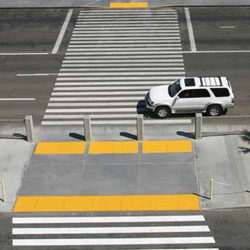









Installing tactile tiles is an important accessibility requirement in public spaces and buildings across Canada. It is an effective solution designed to help pedestrians navigate their surrounding safely & confidently.
However, with the various options available, selecting the right tactile tile for your specific project can get confusing. This blog provides a comprehensive guide that will help you in making the right decision by choosing compliant and long-lasting tactile tiles that perfectly match your unique requirements.
Tactile tiles, also known as Tactile Walking Surface Indicators (TWSIs), are textured ground surfaces that provide critical cues for navigation and hazard detection to pedestrians with visual impairments. Installing these tiles is mandated under the Accessibility for Ontarians with Disabilities Act (AODA) and various provincial building codes in Canada.
Tactile tiles contain either raised domes or elongated bars installed on walking surfaces. The different textures serve specific purposes:
Truncated Domes: Truncated domes, also called as detectable warning tiles, have raised domes in a distinct pattern that alerts pedestrians to upcoming hazards like intersections or platform edges.
Wayfinding Bars: Wayfinding bars contain raised bars that guide pedestrians along designated pathways toward amenities or transit access points.
Tactile tiles can be installed by embedding into concrete or applying onto existing surfaces. They are commonly made from durable, weather-resistant materials like metal, stone, cast iron, rubber, porcelain, and polymers.
Here are the key aspects to evaluate when selecting tactile tiles for your project:
Truncated Domes or Wayfinding Bars - Select tiles with appropriate texture for hazard warnings or path demarcations.
Choose colors that sufficiently contrast with the surrounding surface for high visibility. Safety yellow offers optimal contrast.
Ensure the tiles adhere to all relevant Canadian accessibility codes and standards like AODA and CSA B651.
Tiles must have a slip-resistant texture and slightly beveled edges for safety and to prevent tripping hazards.
When choosing tactile tiles, consider your unique project requirements - whether it's a new construction or renovation, indoor or outdoor setting, high or low foot traffic, slip resistance needed, and accessibility compliance.
Connect with tactile tile manufacturers like Tactile Solution Canada to get product recommendations based on your specifications. Our team can suggest the right tiles tailored to your needs from their wide selection of brands like AccessTile, Armor Tile, Advantage Tile, and more.
Investing in compliant and durable tactile tiles specifically suited for your project ensures safety, accessibility, and long-term value. You can pick tiles that serve both form and function with the right guidance. Reach out to us today for any queries on finding the ideal tactile tiles for your next project.
Tactile tiles contain standardized raised textures and patterns to provide navigation cues for the visually impaired. Regular floor tiles lack such accessible textures.
Quality tactile tiles can last 10-15 years with proper installation and durable material selection. Tiles made of weaker materials may need replacement every 5-8 years.
Quality tactile tiles are designed with an integral slip-resistant texture to maintain traction even when wet. Some materials like porcelain may get more slippery.
Tactile tiles typically just need routine cleaning. Some types, like replaceable polymer tiles, allow easy replacement of damaged sections as needed.
For existing surfaces, tactile tiles come with adhesive backing or are installed using construction adhesives and mechanical fasteners if needed. Edges are often grouted.
